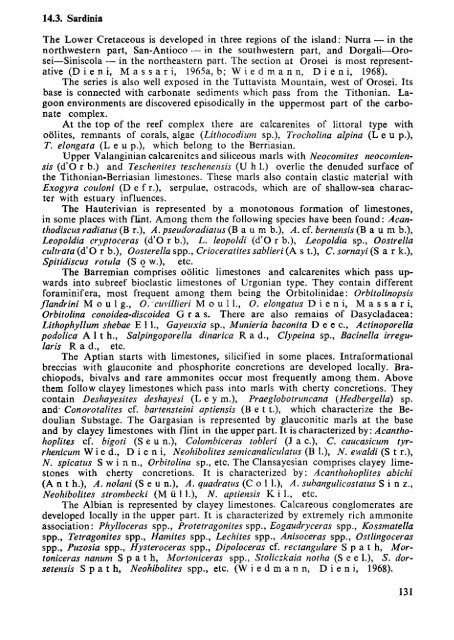THE MEDITERRANEAN LOWER CRETACEOUS
THE MEDITERRANEAN LOWER CRETACEOUS
THE MEDITERRANEAN LOWER CRETACEOUS
You also want an ePaper? Increase the reach of your titles
YUMPU automatically turns print PDFs into web optimized ePapers that Google loves.
14.3. Sardinia<br />
The Lower Cretaceous is developed in three regions of the island: Nurra — in the<br />
northwestern part, San-Antioco — in the southwestern part, and Dorgali—Orosei—Siniscola<br />
— in the northeastern part. The section at Orosei is most representative<br />
(D i e n i, M a s s a r i, 1965a, b;Wiedmann, Dieni, 1968).<br />
The series is also well exposed in the Tuttavista Mountain, west of Orosei. Its<br />
base is connected with carbonate sediments which pass from the Tithonian. Lagoon<br />
environments are discovered episodically in the uppermost part of the carbonate<br />
complex.<br />
At the top of the reef complex there are calcarenites of littoral type with<br />
oolites, remnants of corals, algae (Lithocodium sp.), Trocholina alpina (Leu p.),<br />
T. elongata (Leu p.), which belong to the Berriasian.<br />
Upper Valanginian calcarenites and siliceous marls with Neocomites neocomiensis<br />
(d'O r b.) and Teschenites teschenensis (U h 1.) overlie the denuded surface of<br />
the Tithonian-Berriasian limestones. These marls also contain clastic material with<br />
Exogyra couloni (D e f г.), serpulae, ostracods, which are of shallow-sea character<br />
with estuary influences.<br />
The Hauterivian is represented by a monotonous formation of limestones,<br />
in some places with flint. Among them the following species have been found : Acanthodiscusradiatus<br />
(В г.), A. pseudoradiatus (B a u m b.), A. cf. bernensis (B a u m b.),<br />
Leopoldia cryptoceras (d'O r b.), L. leopoldi (d'O г b.), Leopoldia sp., Oostrella<br />
cultrata (d'O г b.), Oosterella spp., Crioceratitessablieri(A s t.), С. sornayi (S а г к.),<br />
Spitidiscus rotula (S о w.), etc.<br />
The Barremian comprises oolitic limestones and calcarenites which pass upwards<br />
into subreef bioclastic limestones of Urgonian type. They contain different<br />
foraminifera, most frequent among them being the Orbitolinidae: Orbitolinopsis<br />
flandrini M о u 1 g., O.'cuvillieri M о u 1 1., O. elongatus Dieni, Massari,<br />
Orbitolina conoidea-discoidea Gras. There are also remains of Dasycladacea:<br />
Lithophyllum shebae E 11., Gayeitxia sp., Munieria baconita D e e c, Actinoporella<br />
podolica A 11 h., Salpingoporella dinarica R a d., Clypeina sp., Bacinella irregularis<br />
R a d., etc.<br />
The Aptian starts with limestones, silicified in some places. Intraformational<br />
breccias with glauconite and phosphorite concretions are developed locally. Brachiopods,<br />
bivalvs and rare ammonites occur most frequently among them. Above<br />
them follow clayey limestones which pass into marls with cherty concretions. They<br />
contain Deshayesites deshayesi (Ley m.), Praeglobotruncana (Hedbergella) sp.<br />
and' Conorotalites cf. bartensteini aptiensis (Bet t.), which characterize the Bedoulian<br />
Substage. The Gargasian is represented by glauconitic marls at the base<br />
and by clayey limestones with flint in theupperpart.lt is characterized by : Acanthohoplites<br />
cf. bigoti (S e u п.), Colombiceras tobleri (J а с), C. caucasicum tyrrhenicum<br />
W i e d., Dieni, Neohibolites semicanaliculatus (В 1.), N. ewaldi (S t г.),<br />
N. spicatus S w i n п., Orbitolina sp., etc. The Clansayesian comprises clayey limestones<br />
with cherty concretions. It is characterized by: Acanthohoplites abichi<br />
(Ant h.), A. nolani (S e u п.), A. quadratus (С о 1 1.), A. subangulicostatus S i n z.,<br />
Neohibolites strombecki (M ii 11.), N. aptiensis К i 1., etc.<br />
The Albian is represented by clayey limestones. Calcareous conglomerates are<br />
developed locally in the upper part. It is characterized by extremely rich ammonite<br />
association: Phylloceras spp., Protetragonites spp., Eogaudryceras spp., Kossmatella<br />
spp., Tetragonites spp., Hamites spp., Lechites spp., Anisoceras spp., Ostlingoceras<br />
spp., Puzosia spp., Hysteroceras spp., Dipoloceras cf. rectangulare Spath, Mortoniceras<br />
nanum Spath, Mortoniceras spp., Stoliczkaia notha (See 1.), S. dorsetensis<br />
Spath, Neohibolites spp., etc. (W iedmann, Dieni, 1968).<br />
131

















